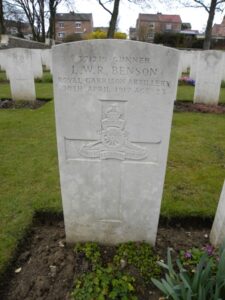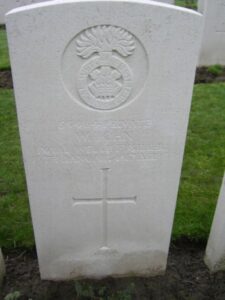Tenby is possibly one of the most attractive towns in West Wales, which can be seen by the number of visitors each summer. The town has a long history, with its castle being in a prominent position overlooking the sea, and the ancient town walls still standing. As a popular beauty spot in Victorian times, Tenby played host to a number of important families, and this can be seen in the large proportion of officers on the War Memorial, which is sited at Trafalgar Gardens. There are also several other war memorials scattered throughout Tenby, including one inside Frog Street Tabernacle Methodist Chapel. This page commemorates the four members of Frog Street Chapel who fell during the Great War. The photograph of the war memorial is courtesy of Dr Gethin Matthews, of Swansea University.

The Great War, 1914-1918
Lionel William Richard Benson, Gunner, 371219, Royal Garrison Artillery. Lionel was the Eldest son of William Walter Benson and Mary Anne Benson, of Gaspard House, Clareston Road, Tenby. He had enlisted at Milford Haven into the Royal Garrison Artillery, and been posted to their 68th Siege Battery in France. The Battery were armed with the 30 cwt 6″ Howitzer, and they fought during the Gommecourt Offensive in July 1916. After spending the remainder of 1916 on the Somme, the Battery moved to Arras, which is where Lionel was wounded. Lionel died of wounds on 30 April 1917, aged 23, and is buried in Ste. Marie Cemetery, Le Havre, France.

Gilbert Douglas Davies, Private, 56886, Welsh Regiment. Gilbert was the son of William Henry and Sarah Ann Davies, of Toronto Cottage, Clareston Road, Tenby. He enlisted at Carmarthen on 5 July 1915 into the Pembroke Yeomanry. On 4 August 1916 Gilbert landed in France, and was posted to the 13th Battalion, Welsh Regiment, which was attached to 114 Brigade, 38th (Welsh) Division, joining the battalion at Ypres, where it was rebuilding after the fighting at Mametz Wood. The 38th Division was by then in positions at the Canal Bank, north of Ypres, and it was here during his first winter on the Western Front that Gilbert was wounded on 15 January 1917. He was evacuated to the 46th Casualty Clearing Station at Mendinghem for treatment, but sadly died of wounds there on 17 January 1917, aged just 21. He is buried at Mendinghem Military Cemetery, Belgium.

William John, Private, 55464, Royal Welsh Fusiliers. William was born at Tenby on 6 August 1883, the son of William John and Margaret John (nee Phillips), of Laugharne. He married Martha Elizabeth Davies in 1908, and the couple raised four children, at 29, Victoria Street, Tenby. William enlisted at Tenby into the Pembroke Yeomanry, but later transferred into the 16th Battalion, Royal Welsh Fusiliers, part of 113 Brigade, 38th (Welsh Division). The Division embarked at Folkestone on 5 December 1915, disembarking at Boulogne the same day. During the winter and spring of 1916 the Battalion held the line in the Armentières sector, and at the end of May, 1916 moved South with the remainder of the 38th (Welsh) Division to the Somme area, in readiness for the First Battle of The Somme. The 38th Division was tasked with the taking of the infamous Mametz Wood, with the first attack going in on 7 July, when the division lost heavily in ‘Death Valley’ during the advance on the ‘Hammer Head’. The next attack went in on 10 July and by 12 July the wood was cleared. Due to the terrible casualties taken by the Division during the capture of Mametz Wood, they were removed from the front, and posted to Ypres to rebuild. William was sadly killed in action during that first winter at Ypres, on 15 January 1917, aged 33. He is buried at Essex Farm Cemetery, Belgium.


Richard Edwin Nock, Gunner, 371194, Royal Garrison Artillery. Richard was born in Newtown, Montgomeryshire in 1895, the son of Richard and Maria Nock. By 1911 he was residing with his Aunt and Uncle George and Elizabeth Davies, at Boston House, Tenby, where he was apprenticed to his Uncle, who was a bootmaker. Richard enlisted at Hubberston into the 114th Siege Battery, Royal Garrison Artillery, which formed there from members of the Pembroke RGA. The Battery moved out to the Western front shortly after, and was at Ypres taking part in the Battle of Messines when Richard was killed by German counter-battery fire on 24 June 1916, aged 22. He is buried at Belgian Battery Corner Cemetery, Belgium.
